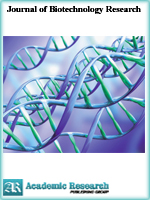Journal of Biotechnology Research
Online ISSN: 2413-3256
Print ISSN: 2413-8878
Print ISSN: 2413-8878
Quarterly Published (4 Issues Per Year)

Archives
Volume 10 Number 1 January 2024
Synergistic Adsorptive Removal of Urea from Agricultural Effluents Using Ball Clay and Sepiolite Composite
Authors: Emmanuel Amuntse Yerima ; Hyelalibiya Ataitiya ; Baba Nwunuji Hikon, et. al.
Pages: 9-19
DOI: doi.org/10.32861/jbr.101.9.19
Abstract
Agriculture effluents have become a big problem since water is the basic component of all operation in agriculture practice. These effluents composed of agrochemicals such as fertilizer, pesticides, herbicides, crop residues are the pollutants of agricultural effluents. Lakes, rivers and streams often receives water run-off from farmlands. Nitrates and urea in the water bodies are toxic to aquatic lives by causing depletion of oxygen in water making it unfit for human and aquatic life. This research assessed the adsorptive removal of urea from agricultural effluent by means of thermally activated ball clay and sepiolite composite (TABCSC) and non-activated ball clay and sepiolite composite (NABCSC) as absorbent. The adsorption process was done at Varying amounts TABCSC (0.6g - 4.5g), pH range of 3 - 11, time (30 - 90 minutes) and temperature (25 – 45°C) as recommended by design expert version 13. TABCSC and NABCSC characterized by means of Fourier transformed infrared spectroscopy (FTIR) and scanning electron microscope (SEM) reveals the presence of large surface area, porosity as well as the functional groups: hydroxyl, carboxylic, hydrogen bonding and aldehyde group that aids adsorptive removal of urea. The highest adsorptive removal efficiency by TABCSC was found to be 99.23% (at pH = 7, temperature = 25°C, dosage = 0.6 g and time = 60 minutes) while that of NABCSC was at 93.23% (at pH = 11, temperature = 35°C, dosage = 0.6 g and time = 60 minutes). The adsorptive removal of urea was found to increase with increase in pH value and contact time. The adsorptive removal mechanism of Urea by TABCSC was more fitting to the second order kinetics (R2 = 0.9770) while removal by NABCSC aligns with the pseudo first order kinetics (R2 = 0.9770). The isotherm of the removal process conforms more to the Freundlich isotherm of TABCSC (R2 = 0.9995) and NABCSC (R2 = 0.9671) respectively.
Extraction and Comparison of Anthocyanin Content in Seeds of Different Black Rice Varieties Using Water Bath Solution Extraction Method
Authors: Bo Peng ; Hao-Jia He ; Wan-Ru Zhang, et. al.
Pages: 1-8
DOI: doi.org/10.32861/jbr.10.1.1.8
Abstract
Black rice, rare colored rice, is rich in anthocyanins. Black rice anthocyanin is a kind of natural plant pigment, which has the important effects of anti-oxidation, anti-inflammation and anti-cancer, protecting eyesight and promoting cardiovascular health. Fifteen representative black rice seeds in Southern Henan were used as test materials, and were determined and analyzed by using rice huller, visible light spectrophotometer and water bath solution extraction method and microwave assisted extraction method. The results showed that the anthocyanin content of different varieties of black rice varies greatly, among which the anthocyanin content of black fragrant glutinous rice No. 2 was the highest (0.4258%), and that of black fragrant glutinous rice No.4 was the lowest (0.0207%). The average content of anthocyanin in seeds of black rice varieties tested in Southern Henan Province was 0.1925%. Therefore, the above research results provide important clues for the genetic breeding and improvement of high-quality black rice varieties in Southern Henan. At the same time, varieties with higher anthocyanin content in black rice can be considered as backbone parents for new breeding high-quality black rice.



